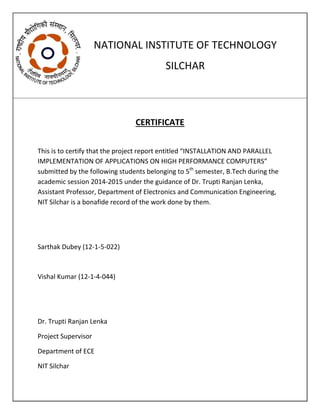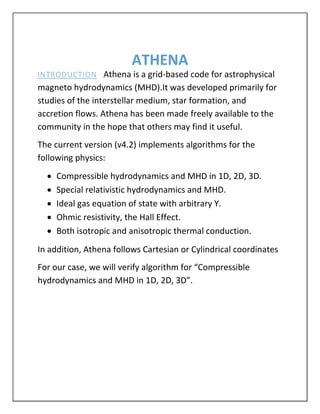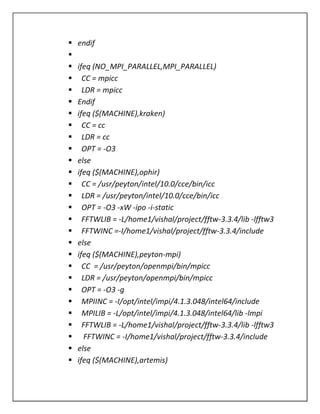HARD COPY REPORT CDAC
- 1. PROJECT REPORT ON INSTALLATION AND PARALLEL IMPLEMENTATION OF APPLICATIONS ON HIGH PERFORMANCE COMPUTERS NITS Supercomputing Facility NATIONAL INSTITUTE OF TECHNOLOGY SILCHAR Submitted By ŌĆō SARTHAK DUBEY VISHAL KUMAR 12-1-5-022 12-1-4-044 Computer Science and Engg. Electronic and Communictation Engg Under the guidance of Dr. Trupti Ranjan Lenka Assistant Professor, Dept. of ECE
- 2. NATIONAL INSTITUTE OF TECHNOLOGY SILCHAR CERTIFICATE This is to certify that the project report entitled ŌĆ£INSTALLATION AND PARALLEL IMPLEMENTATION OF APPLICATIONS ON HIGH PERFORMANCE COMPUTERSŌĆØ submitted by the following students belonging to 5th semester, B.Tech during the academic session 2014-2015 under the guidance of Dr. Trupti Ranjan Lenka, Assistant Professor, Department of Electronics and Communication Engineering, NIT Silchar is a bonafide record of the work done by them. Sarthak Dubey (12-1-5-022) Vishal Kumar (12-1-4-044) Dr. Trupti Ranjan Lenka Project Supervisor Department of ECE NIT Silchar
- 3. ACKNOWLEDGEMENT We would like to express our sincere gratitude and avail this opportunity to express our indebtedness to our supervisor Dr. Trupti Ranjan Lenka, Assistant Professor, Department of Electronics and Communication Engineering, National Institute of Technology Silchar, for his valuable guidance, constant encouragement and kind help at various stages for the execution of this work. His enthusiasm has always encouraged us to seek for knowledge in all forms of source. We would also like to thank our guides Mr. Souvik Paul, Project Engineer, CDAC Pune and Mr. Kiran Sonavane, Project Engineer, CDAC Pune for thoroughly teaching us the required theory and guiding us throughout the practical sessions. Place: NIT Silchar Sarthak Dubey (12-1-5-022) Date: 25-7-2014 Vishal Kumar (12-1-4-044)
- 4. Table of Contents Chapter 1 Athena 1.1 Introduction 3 1.2 Usable Links 4 1.3 Installation Steps 4 1.4 Running Steps(Serial) 5 1.5 1D Hydrodynamics Prob 5 1.6 2D-MDH Problem 7 1.7 3D-MDH Problem 8 1.8 Running Steps(Parallel) 10 1.9 Table
- 5. ATHENA INTRODUCTION Athena is a grid-based code for astrophysical magneto hydrodynamics (MHD).It was developed primarily for studies of the interstellar medium, star formation, and accretion flows. Athena has been made freely available to the community in the hope that others may find it useful. The current version (v4.2) implements algorithms for the following physics: ’éĘ Compressible hydrodynamics and MHD in 1D, 2D, 3D. ’éĘ Special relativistic hydrodynamics and MHD. ’éĘ Ideal gas equation of state with arbitrary Y. ’éĘ Ohmic resistivity, the Hall Effect. ’éĘ Both isotropic and anisotropic thermal conduction. In addition, Athena follows Cartesian or Cylindrical coordinates For our case, we will verify algorithm for ŌĆ£Compressible hydrodynamics and MHD in 1D, 2D, 3DŌĆØ.
- 6. USABLE LINKS: https://trac.princeton.edu/Athena/wiki/AthenaDocsDownLd INSTALLATION STEPS: 1. After having downloaded the file, we transfer it from the windows to the MobaXterm through WinSCP. 2. The file is in the ŌĆ£.gz.tarŌĆØ format. So; it is first made untar and gunzipped from the command given below. ’āś gunzip athena4.2.tar.gz ’āś tar xf athena4.2.tar.gz 3. Then ,the configure script is created by running autoconfig in the ./athena directory using the command: ’āś cd athena 4.2 ’āś autoconf 4. Now, test the configure by running : ’āś Configure ’āś make all ’āś make test 5. The above steps will have executable in a new directory ./athena/bin. It contains the ŌĆ£athinput.newŌĆØ file too. ’āś cd bin
- 7. Running steps (serial) ’āś 1D hydrodynamics problem The Sod shock tube To run a simple 1D hydrodynamic problem, following steps are followed: 1. Enter the athena4.2 directory. ’āś cd athena4.2 2. Clean up any old files from the last compilation. ’āś make clean 3. Configure the code for hydrodynamics and the shock tube problem generator: ’āś configure --with-gas=hydro --with-problem=shkset1d 4. Compile. This will create the /bin directory, if it does not already exist. ’āś make all 5. Run the code using the default input file for the Sod shock tube. ’āś cd bin ’āś athena -i../tst/1D-hydro/athinput.sod 6. The code should have produced a series of .tab files, and a history file: Athena Sod.0005.tab Sod.0011.tab Sod.0017.tab Sod.0023.tab Sod.0000.tab Sod.0006.tab Sod.0012.tab Sod.0018.tab Sod.0024.tab Sod.0001.tab Sod.0007.tab Sod.0013.tab Sod.0019.tab Sod.0025.tab Sod.0002.tab Sod.0008.tab Sod.0014.tab Sod.0020.tab Sod.hst Sod.0003.tab Sod.0009.tab Sod.0015.tab Sod.0021.tab Sod.0004.tab Sod.0010.tab Sod.0016.tab 7. After the above step, the screen below gets appeared.
- 8. 8. Now plotting is done using the GNU. The commands are : ’āś gnuplot ’āś plot[0:1028] ŌĆ£Sod.0025.tabŌĆØ u 3:1 9. The following screen comes:
- 9. 2D-MHD problem: The Orszag-Tang Vortex To run an example 2D MHD problem, follow these steps: 1. Clean up any old files from the last compilation, configure, and compile ’āś make clean ’āś configure --with-problem=orszag-tang --with-order=3 ’āś make all 2. Run the code using the default input file for the Orszag-Tang vortex ’āścd bin ’āś athena -i../tst/2D-mhd/athinput.orszag-tang 3. The following screen appears: 4. Now ,the animation of the file is done by the command given with the output: ’āś animate *.d.ppm
- 10. 3D MHD Problem: The Rayleigh-Taylor Instability To run an example 3D MHD problem, follow these steps. 1. Clean up any old files from the last compilation, configure, and compile. ’āś make clean ’āś configure --with-problem=rt --with-order=3 ’āś make all 2. Run the code using the default input file. Because 3D problems are very expensive, it is wise to reduce the grid resolution if we are running on a single processor. This can be done using the command line. ’āś cd bin ’āś athena -i../tst/3D-mhd/athinput.rt domain1/Nx1=32 domain1/Nx2=32 domain1/Nx3=64 time/tlim=3.0 Even at this reduced resolution, the run will take close to an hour to complete. Doubling the resolution in each dimension increases the run time in 3D by 24 =16 (a factor of 2 for each dimension, plus a factor of 2 for the smaller time step), so if the default grid resolution specified in the input file is used, this
- 11. test will take upwards of 12 hours to run (these numbers depend on the processor you are using of course). At low resolution, the bubbles (fingers) tend to rise (sink) faster, so the run is terminated at t=3 before they hit the top and bottom of the domain. 3. If any editing is required, that can be done in /bin/athinput.new using command: ’āś vim /bin/athinput.new 4. Run the code using: ’āś athena ŌĆōi athinput.new 5. Animate the following as; ’āś animate *.d.ppm
- 12. Running Steps (PARALLEL) Why Parallelizing? In the case of 3D-MHD,it takes hours to run the file if only single processor is used. Therefore to overcome the problem, parallelizing of the program is done in which multiple processors are utilized to run the program which results in the drastic contraction of time .So the concept of MPI comes into picture. Running Athena with MPI Virtually all new laptops and PCs have at least dual or quad core processors. This means we can get up to a 2x or 4 x speed-ups by using all the cores at once. If we can get access to a workstation or cluster with multiple processors, we can get much larger speed-ups. Athena has been run on clusters with up to 25,000 cores. However, running Athena with MPI requires an external MPI library (OpenMPI, for example) be installed on the system. As an example, to run the 3D MHD RT instability problem with MPI, follow these steps. 1. Clean up any old files from the last compilation, and enable MPI during configure. ’āś make clean ’āś configure --with-problem=rt --with-order=3 --enable-mpi 2. A dependency ŌĆ£fftw-3.3.4ŌĆØ is required which can be downloaded from the link: http://www.fftw.org/download.html 3. Now the file is transferred to the Mobaxterm from windows through WinSCP. 4. Untar the file using the command: ’āśtar xf fftw-3.3.4.tar
- 13. 5. Enter into the fftw-3.3.4 directory, and configure it using the commands. ’āścd fftw-3.3.4 ’āśvi README ’āś ./configure ŌĆōprefix=/home1/vishal/project/fftw-3.3.4 ’āś make all ’āś make install 6. The above steps will enable the fftw-3.3.4 directory to possess bin, include and lib file. 7. Now, follow the commands: ’āś cd project ’āś vi Makeoptions 8. Edit the Makeoptions file by giving the path to it as; ’é¦ CC = /opt/intel/impi/4.1.3.048/intel64/bin/mpicc ’é¦ LDR = /opt/intel/impi/4.1.3.048/intel64/bin/mpicc ’é¦ OPT = -O3 ’é¦ CUSTLIBS = ’é¦ MPIINC =-I/opt/intel/impi/4.1.3.048/intel64/include ’é¦ MPILIB =-L/opt/intel/impi/4.1.3.048/intel64/lib -lmpi ’é¦ FFTWLIB =-L/home1/vishal/project/fftw-3.3.4/lib -lfftw3 ’é¦ FFTWINC =-I/home1/vishal/project/fftw-3.3.4/include ’é¦ BLOCKINC = ’é¦ BLOCKLIB = ’é¦ CUSTLIBS = -ldl ŌĆōlm ’é¦ ifeq (NO_FFT,FFT_ENABLED) ’é¦ BLOCKINC = -I fftsrc ’é¦ FFTWLIB = -L/home1/vishal/project/fftw-3.3.4/lib -lfftw3 ’é¦ FFTWINC = -I/home1/vishal/project/fftw-3.3.4/include
- 14. ’é¦ endif ’é¦ ’é¦ ifeq (NO_MPI_PARALLEL,MPI_PARALLEL) ’é¦ CC = mpicc ’é¦ LDR = mpicc ’é¦ Endif ’é¦ ifeq ($(MACHINE),kraken) ’é¦ CC = cc ’é¦ LDR = cc ’é¦ OPT = -O3 ’é¦ else ’é¦ ifeq ($(MACHINE),ophir) ’é¦ CC = /usr/peyton/intel/10.0/cce/bin/icc ’é¦ LDR = /usr/peyton/intel/10.0/cce/bin/icc ’é¦ OPT = -O3 -xW -ipo -i-static ’é¦ FFTWLIB = -L/home1/vishal/project/fftw-3.3.4/lib -lfftw3 ’é¦ FFTWINC =-I/home1/vishal/project/fftw-3.3.4/include ’é¦ else ’é¦ ifeq ($(MACHINE),peyton-mpi) ’é¦ CC = /usr/peyton/openmpi/bin/mpicc ’é¦ LDR = /usr/peyton/openmpi/bin/mpicc ’é¦ OPT = -O3 -g ’é¦ MPIINC = -I/opt/intel/impi/4.1.3.048/intel64/include ’é¦ MPILIB = -L/opt/intel/impi/4.1.3.048/intel64/lib -lmpi ’é¦ FFTWLIB = -L/home1/vishal/project/fftw-3.3.4/lib -lfftw3 ’é¦ FFTWINC = -I/home1/vishal/project/fftw-3.3.4/include ’é¦ else ’é¦ ifeq ($(MACHINE),artemis)
- 15. ’é¦ CC = mpicc ’é¦ LDR = mpicc ’é¦ OPT = -O3 -xW -ipo -i-static ’é¦ MPIINC = ’é¦ MPILIB = -lmpi ’é¦ FFTWLIB = -L/home1/vishal/project/fftw-3.3.4/lib -lfftw3 ’é¦ FFTWINC = -I/home1/vishal/project/fftw-3.3.4/include ’é¦ else ’é¦ ifeq ($(MACHINE),aether) ’é¦ CC = mpicc ’é¦ LDR = mpicc ’é¦ OPT = -O3 ’é¦ MPIINC = -I~/lam-7.1.4/include ’é¦ MPILIB = -L~/lam-7.1.4/lib ’é¦ Else ’é¦ ifeq ($(MACHINE),zenith) ’é¦ CC = mpicc ’é¦ LDR = mpicc ’é¦ OPT = -O3 ’é¦ MPIINC = -I/opt/intel/impi/4.1.3.048/intel64/include ’é¦ MPILIB = -L/opt/intel/impi/4.1.3.048/intel64/lib -lmpi ’é¦ FFTWLIB = -L/home1/vishal/project/fftw-3.3.4/lib -lfftw3 ’é¦ FFTWINC = -I/home1/vishal/project/fftw-3.3.4/include ’é¦ else ’é¦ ifeq ($(MACHINE),macosx) ’é¦ CC = gcc ’é¦ LDR = gcc ’é¦ OPT = -O3
- 16. ’é¦ FFTWLIB = -L/home1/vishal/project/fftw-3.3.4/lib -lfftw3 ’é¦ FFTWINC = -I/home1/vishal/project/fftw-3.3.4/include ’é¦ else ’é¦ abort Unsupported MACHINE=$(MACHINE) ’é¦ endif ’é¦ endif ’é¦ endif ’é¦ endif ’é¦ ifeq (NO_MPI_PARALLEL,NO_MPI_PARALLEL) ’é¦ MPIINC = ’é¦ MPILIB = ’é¦ endif ’é¦ ifeq (NO_FFT,NO_FFT) ’é¦ FFTWINC = ’é¦ FFTWLIB = ’é¦ endif ’é¦ ’é¦ CFLAGS = $(OPT) $(BLOCKINC) $(MPIINC) $(FFTWINC) ’é¦ LIB = $(BLOCKLIB) $(MPILIB) $(FFTWLIB) $(CUSTLIBS) After having done the editing in the makeoptions file, we will go to the athinput.new file in order to change the parameter of the program to run. cd bin cp ../tst/3D-mhd/athinput.rt athinput.new To decompose the grid into 8 32*32*64 blocks use , <domain1>
- 17. ... NGrid_x1 = 2 NGrid_x2 = 2 NGrid_x3 = 2 ... Now, the program can be run using the command; mpirun -np 8 athena -i athinput.new time/tlim=4.0
- 18. The following output will come via the cycle running as follows: The number of processors running is shown here:








![8. Now plotting is done using the GNU. The commands are :
’āś gnuplot
’āś plot[0:1028] ŌĆ£Sod.0025.tabŌĆØ u 3:1
9. The following screen comes:](https://image.slidesharecdn.com/f4d6722d-d6fc-4b78-a64e-8e2843b0d144-150810135234-lva1-app6891/85/HARD-COPY-REPORT-CDAC-8-320.jpg)










